and yet…
Posted: September 10, 2019 Filed under: activ8, the ash tree | Tags: art and science, Arte Povera, climate crisis, climate emergency, eco art, ecopsychology, Feeling, Interdisciplinarity, Meditation, poetry, Prayer Leave a commentthis climate emergency, part 2
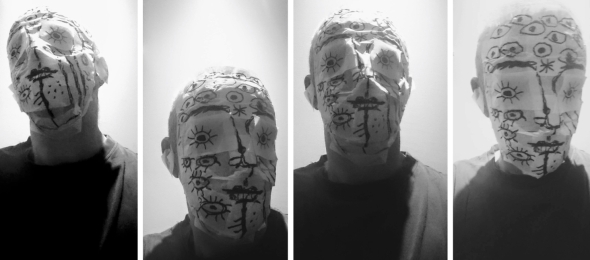 drawing on my face 4: seeing (masking tape and marker pen on human head) © p ward 2019
drawing on my face 4: seeing (masking tape and marker pen on human head) © p ward 2019
and yet,
the sun and moon still rise and fall
birds sing
grass grows
everything is somehow in place.
despite imagery evocative of an abrupt demise,
despite rising popular opinion and attendant fearful frenzy,
despite the corroboration of a high percentage of scientific peers,
despite indicative physical, ideological and pecuniary global suffering and conflict,
despite a lifelong personal acknowledgement of our continuing abuse of Nature…
I do not sense
I do not feel
the end.
I cannot sense
I cannot feel
the end.
I do not, cannot
and will not accept
the end.
so what of instinct and intuition (the antithesis of science)?
what of individual response?
what of collective consciousness?
what of the uninformed, the common man?
are we, en masse, running from the ensuing fire?
and anyway, where can we run in this apparent global catastrophe?
if I do not feel it,
if I stand aside the mindful stampede,
am I simply burying my head in the sand
in denial of empirical objectivity,
in fear of the inevitable?
or is it that
I do not know within my power what more I may do?
as I stand on this excellent brink of oblivion, this ending of sorts,
with the knowledge, wisdom and capability of all I have before
there is opportunity
there is technology
and there is love.
I must either believe in the magic and wonder of the human spirit within Nature or not
like every day
like any day
I breath
I choose
I act according to (my) Nature…
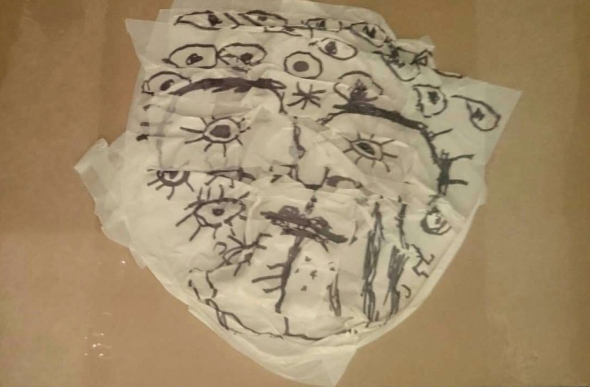 drawing on my face 4: seeing (masking tape and marker pen on human head) © p ward 2019
drawing on my face 4: seeing (masking tape and marker pen on human head) © p ward 2019
© P Ward 2019
no light no colour no more
Posted: February 25, 2019 Filed under: eARTh | Tags: Aesthetics, art and science, Arte Povera, Arts, arts research, Cornwall, earth pigments, eco art, ecopsychology, Environmental art, Feeling, indigenous culture, painting, Pigment, Visual arts 2 Commentsfurther material responses to existential emergence, crisis and change
I was reminded recently, while gazing fleetingly into the shimmering turquoise green blue ocean here in West Cornwall, of my early art training based in the classical understanding of colour. colour as light. a systematic mixing together of homogenous materials to represent the colours that we observe in Nature from a set of ‘primaries’: reds, blues and yellows. no black. white in moderation. of hue.
 iron board, Praa Sands, Cornwall (Cornish earth pigments on rock) © p ward 2019
iron board, Praa Sands, Cornwall (Cornish earth pigments on rock) © p ward 2019
our perception of colour, of light and shade, and hence of depth, size, form and materiality, is sometimes explained as the processing and communication of visual information created by the reflection, refraction and absorption of light in relation to materials. working with earth pigments has revealed ‘colour’ as more than just a visual ‘scientific’ process of perception. it is more a holistic appreciation of material presence which encompasses not just colour but texture, smell and a provenance of time and place, of formation and decay, of ecology, history and Nature itself.
we may often associate earth colours with a range of browns, reds and yellows. with this latest set of paintings I have been enjoying a more subtle selection of greys, greens, mauves and whites that I have found, gathered and mixed near my home.
I could say that the stories they tell are unique expressions of their own experience that I have been privileged to bring into contemporary form, but maybe that is for you to decide…
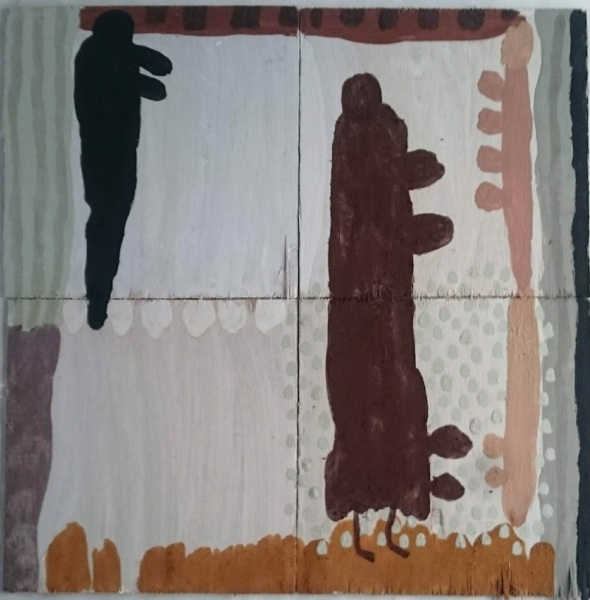 aspects of landscape and love – today it snowed (Cornish earth pigments on board; 51x51cm) © p ward 2019
aspects of landscape and love – today it snowed (Cornish earth pigments on board; 51x51cm) © p ward 2019
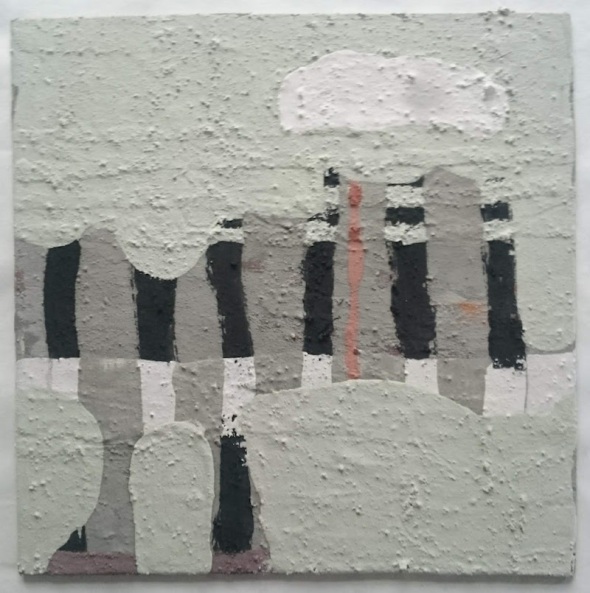 the beautiful things that people say when they are together (Cornish earth pigments on board; 25x25cm) © p ward 2019
the beautiful things that people say when they are together (Cornish earth pigments on board; 25x25cm) © p ward 2019
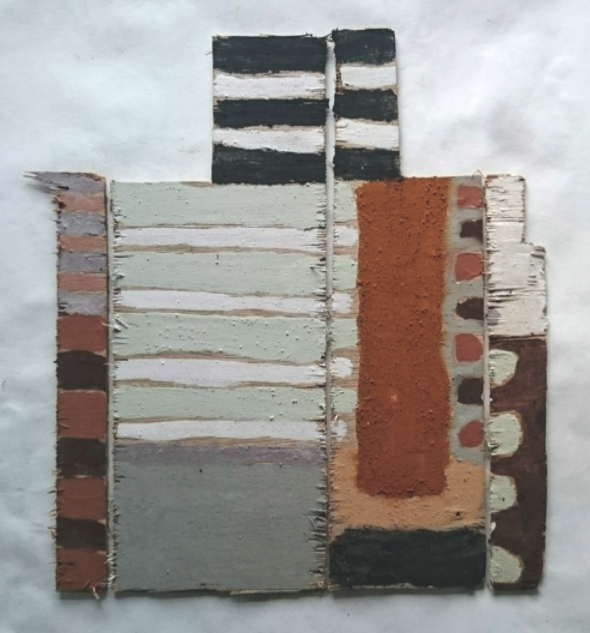 facing up to facing up to (Cornish earth pigments on board; 31x33cm) © p ward 2019
facing up to facing up to (Cornish earth pigments on board; 31x33cm) © p ward 2019
 rearranging the furniture (Cornish earth pigments on board; 35x35cm) © p ward 2019
rearranging the furniture (Cornish earth pigments on board; 35x35cm) © p ward 2019
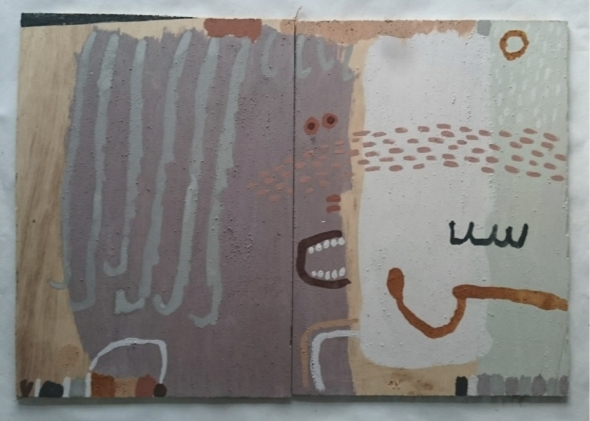 like chopping onions in a northwesterly gale (Cornish earth pigments on board; 56x38cm) © p ward 2019
like chopping onions in a northwesterly gale (Cornish earth pigments on board; 56x38cm) © p ward 2019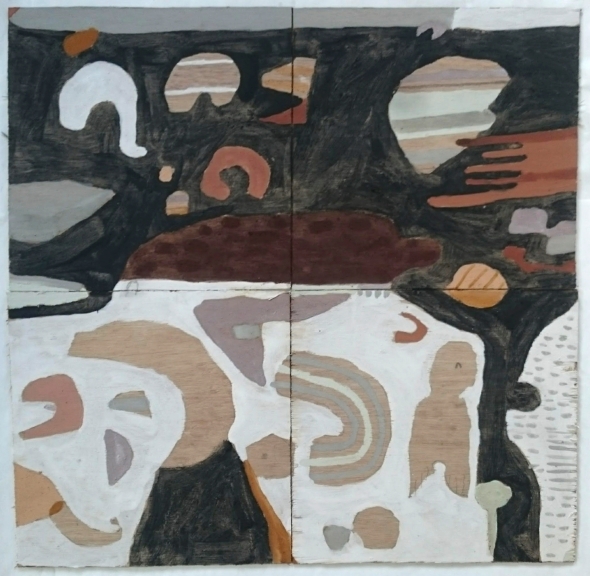 stones that stand in fields with swans and cows and geese: penwith (Cornish earth pigments on board; 70x68cm) © p ward 2019
stones that stand in fields with swans and cows and geese: penwith (Cornish earth pigments on board; 70x68cm) © p ward 2019
 simple communication here (Cornish earth pigments on card; 61x51cm) © p ward 2019
simple communication here (Cornish earth pigments on card; 61x51cm) © p ward 2019
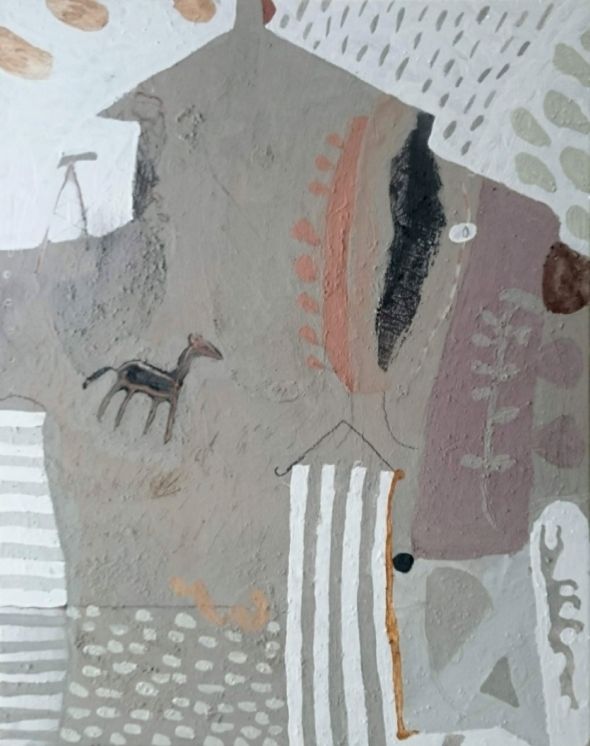 house of power (Cornish earth pigments on canvas; 40x50cm) © p ward 2019
house of power (Cornish earth pigments on canvas; 40x50cm) © p ward 2019
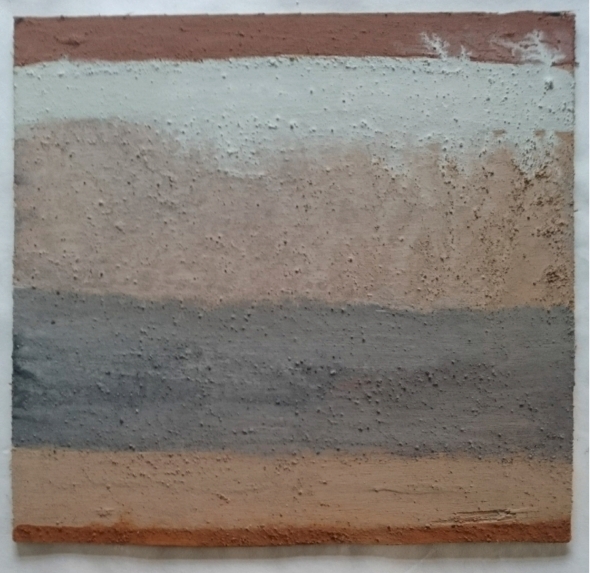 nondescript (Cornish earth pigments on board; 27x26cm) © p ward 2019
nondescript (Cornish earth pigments on board; 27x26cm) © p ward 2019
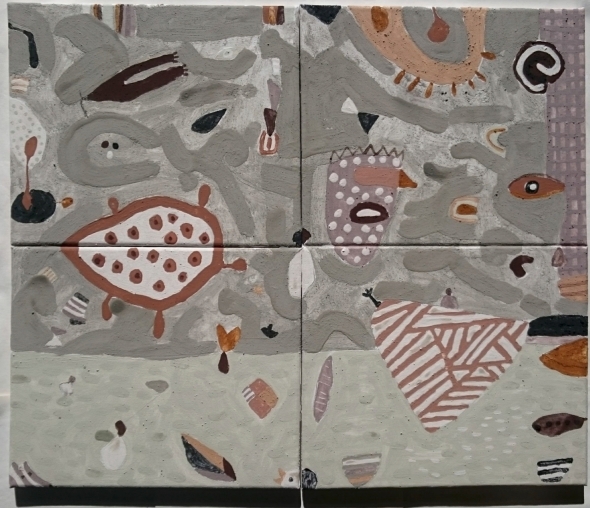 turning a new leaf with foxes on my mind (Cornish earth pigments on canvas; 61x51cm) © p ward 2019
turning a new leaf with foxes on my mind (Cornish earth pigments on canvas; 61x51cm) © p ward 2019
© P Ward 2019
7 Cornish Pigments: first findings
Posted: August 31, 2018 Filed under: eARTh, educ8 | Tags: art and science, Arte Povera, arts research, British Art, Cornish Art, Cornish mining, Cornwall, earth pigments, eco art, Ecology, ecopsychology, Environmental art, Interdisciplinarity, Mining 1 CommentTHIS TOXIC(?) BEAUTY
 Cornish Landscape (raw and ground Cornish pigments) © p ward 2018
Cornish Landscape (raw and ground Cornish pigments) © p ward 2018
The 7 colours shown here have been gathered close to historic mining sites in west Cornwall. Some are waste products from tin and copper mining and may contain toxic minerals such as arsenic and cadmium, ironically both used historically in paint and pigment production. Despite being found alongside public rights of way until sufficient mineral analysis has been made of the samples I am unable to share them with the public.
However, I am comfortable enough to start using them myself (with care). Inspired by the milling process used to extract tin I have started to mix the raw materials with water before filtering with a fine sieve. This minimizes the grinding process and hence the possible inhalation of dust. So far I have only used PVA glue as a binder but enjoyed the difference in colour, provenance and nature of the pigments compared to the North Devon pigments I am more familiar with. As such the imagery has started to take on its own character relevant to the materials, the geographical space and my personal experience of Penwith and west Cornwall. I am currently working with Geevor Tin Mine Museum to develop educational workshops using the pigments. The mine itself and attendant museum is utterly fascinating allowing me to better understand the differences between pigments from natural landforms and those extracted from deep underground. In due time I will be able to better share my findings but for the time being here are some of my first paintings made using the wonderful, beautiful but maybe a little toxic Cornish pigments.
As yet the paintings are relatively small (up to 60x60cm) but I look forward to taking some of these ideas to a larger scale and context. If you are interested in any of the work shown here or would like to support or contribute to any further research please get in touch.
 7 Cornish pigments – paint samples on paper @ p ward 2018
7 Cornish pigments – paint samples on paper @ p ward 2018
 Cornish Quilt (Cornish earth pigments on paper) © p ward 2018
Cornish Quilt (Cornish earth pigments on paper) © p ward 2018
 6x6x6 (Cornish earth pigments on paper) © p ward 2018
6x6x6 (Cornish earth pigments on paper) © p ward 2018
 red, grey, green (Cornish earth pigments on paper) © p ward 2018
red, grey, green (Cornish earth pigments on paper) © p ward 2018
 grey, green, white, mauve I-III (Cornish earth pigments on wood) © p ward 2018
grey, green, white, mauve I-III (Cornish earth pigments on wood) © p ward 2018
 fox walking (Cornish earth pigments on wood) © p ward 2018
fox walking (Cornish earth pigments on wood) © p ward 2018
 dagdu (Cornish earth pigments on board) © p ward 2018
dagdu (Cornish earth pigments on board) © p ward 2018
 in landscape I-V (Cornish earth pigments on paper) © p ward 2018
in landscape I-V (Cornish earth pigments on paper) © p ward 2018
 botallack black – arches, obliterate, behind a rainbow (Cornish earth pigments on paper) © p ward 2018
botallack black – arches, obliterate, behind a rainbow (Cornish earth pigments on paper) © p ward 2018
 vertical palette (Cornish earth pigments on board) © p ward 2018
vertical palette (Cornish earth pigments on board) © p ward 2018
 untitled – explorations in colour and form I-IV (Cornish earth pigments on board) © p ward 2018
untitled – explorations in colour and form I-IV (Cornish earth pigments on board) © p ward 2018
 falling (Cornish earth pigments on board) © p ward 2018
falling (Cornish earth pigments on board) © p ward 2018
 in relationship I-III (Cornish earth pigments on board) © p ward 2018
in relationship I-III (Cornish earth pigments on board) © p ward 2018
 in relationship – butterfly (Cornish earth pigments on canvas) © p ward 2018
in relationship – butterfly (Cornish earth pigments on canvas) © p ward 2018
 storyteller IV (Cornish earth pigments on canvas) © p ward 2018
storyteller IV (Cornish earth pigments on canvas) © p ward 2018
 bird box (Cornish earth pigments on wood) © p ward 2018
bird box (Cornish earth pigments on wood) © p ward 2018
 4 vertical colours (Cornish earth pigments on board) © p ward 2018
4 vertical colours (Cornish earth pigments on board) © p ward 2018
 sketch I and II (Cornish earth pigments on paper) © p ward 2018
sketch I and II (Cornish earth pigments on paper) © p ward 2018
 house on wheels – sketch (Cornish earth pigments on paper) © p ward 2018
house on wheels – sketch (Cornish earth pigments on paper) © p ward 2018
With thanks to the people and places of west Cornwall. In particular, the staff of Geevor Tin Mine, Fiona, Natasha and of course Francesca and family for your inspiration and support.
© P Ward 2018
home: research, research and inspiration – early 2016 update
Posted: June 15, 2016 Filed under: A BUNDLE OF STICKS, activ8, BIOSPHERic, eARTh, Uncategorized | Tags: art and science, Arte Povera, arts research, collaboration, Devon, Earth, earth pigments, East Devon, eco art, Ecology, ecopsychology, Environmental art, Feeling, indigenous culture, Interdisciplinarity, North Devon, North Devon Coast, Pigment, poetry, Soil Culture 2 Commentswater, air and earth
sticks and stones
and, somewhere, fire
.
as the year unfolds
to a new life
within us
.
and you grow
and hold us rapt
in your emphatic personality
.
we deliberate upon Nature
each delicate
and deafening response
.
there is red and black and grey and green
dirt to some
riches to others
.
grinding away
what is left
to leave
.
more
and more
and more
.
we play
and learn
we play together
.
knees
teeth
home
.
 home: County Clare, Ireland © p ward 2016
home: County Clare, Ireland © p ward 2016
The year began with family and friends in a rainswept County Clare, Ireland, my home for 10 years. Many of the places I wanted to revisit and share were beneath meters of water. Things, of course, had changed for better and worse but the spirit of the land still shone through.
 home: Lake Vyrnwy, Powys, Wales © p ward 2106
home: Lake Vyrnwy, Powys, Wales © p ward 2106
Then more mountains and lakes, family and friends, as my brother’s path shifts to the Welsh borders, an area I have not visited before but will visit again. This time snow, ice, fog and sunshine accompanied my journey. Lake Vyrnwy reservoir submerged a Welsh village to supply England with water.
 home: Ilfracombe, winter 2016 © p ward 2016
home: Ilfracombe, winter 2016 © p ward 2016
And at ‘home’ the winter lashes the coastline, reshaping and reforming. Ilfracombe was originally named after King Alfred and was gifted to two of his sons as a sheltered harbour on the western approaches to his kingdom. Before then an iron-age hill fort overlooked the natural harbour from, what is now, Hillsborough nature reserve. This part of the North Devon coast is formed predominantly from Devonian slates, sandstones and shales and boasts some of the highest sea cliffs in England. We have a new studio here that we hope will provide a base for our creative endeavours and space for others to enjoy.
 home: Barnstaple Bay and Hele, North Devon © p ward 2016
home: Barnstaple Bay and Hele, North Devon © p ward 2016
 home: Holdstone Down, Combe Martin, North Devon © p ward 2016
home: Holdstone Down, Combe Martin, North Devon © p ward 2016
 let’s talk dirt! (White Moose Gallery, CCANW, Heritage Lottery Fund, Bideford Pottery, IGI Ltd, Roger Cockram)
let’s talk dirt! (White Moose Gallery, CCANW, Heritage Lottery Fund, Bideford Pottery, IGI Ltd, Roger Cockram)
In May, as part of the CCANW Soil Culture project, I led a walk and talk with the White Moose Gallery and supported by the Heritage Lottery Fund, to celebrate North Devon’s relationship with its earth resources. “Let’s Walk and Talk Dirt!” involved local potters, Harry Juniper and Roger Cockram, geologists Chris Cornford and Andrew Green, and soil scientist David Hogan to present some different perspectives about our local resources. Participants really enjoyed the interdisciplinary nature of the events but were frustrated by the lack of time to explore the subject matter in more depth. We are now working towards a ‘summer school’ to further explore North Devon’s potteries, pigments, rocks and soils.
 Sidmouth, East Devon © p ward 2106
Sidmouth, East Devon © p ward 2106
 Jacob’s Ladder beach, Sidmouth, East Devon © p ward 2016
Jacob’s Ladder beach, Sidmouth, East Devon © p ward 2016
The Thelma Hulbert Gallery, Honiton, East Devon invited me in May, to run painting with earth workshops to accompany their ongoing Soil Culture exhibitions. The first workshop introduced the ideas to a small group of partially sighted children from the WESC Foundation, providing a space for us to enjoy the more than visual experience of the process and materials. I was also excited to be exploring a new area of the country, encouraging me to find new pigments and learn about their geology and history. The second workshop, for artists, included an invigorating morning field trip to Jacob’s Ladder beach in Sidmouth to gather small quantities of the iron-rich red and green mudstones, and whatever else took our fancy, followed by an afternoon of furious experimentation grinding and binding a selection of pigments with a variety of mediums. It was great to meet some new faces in such a lively and friendly gallery.
 home: Wessex – Branscombe beach, East Devon; Hardy country (chalk and flint) © p ward 2016
home: Wessex – Branscombe beach, East Devon; Hardy country (chalk and flint) © p ward 2016
Something that did surprise me was the presence of chalk in the landscape of East Devon. Having been raised in Portsmouth I am familiar with the chalk and flint of the South Downs and Isle of Wight but wasn’t aware of it so far west along the coast. The sedimentary Cretaceous beds at Beer, that I saw from Branscombe beach during a day of research, lie above Upper Greensand that then rests on the more familiar Mercian Triassic red mudstones of South Devon. Apparently there is an ‘unconformity’ here in that the interceding Jurassic layer is missing, the area being land during that era. The nodules of flint and chert present in the Chalk and Upper Greensand that make up the beaches are also apparent in the local architecture creating further similarities to the South Downs and other Chalk areas across Europe.
One such region, that I also feel an affinity with through my ancestry and boyhood cycling adventures, is the Wessex Downs. The ancient country of Wessex encompassed Hampshire, west to the Cornish borders, and Wiltshire, Dorset, Devon and Somerset. In more recent times its character and characters have formed the backdrop for the literary works of Thomas Hardy. I was recently contacted by a research fellow from Exeter University to collaborate in a project to explore the value to health and well being of arts-based environmental workshops. His previous research looked at the work of Thomas Hardy in relation to the Wessex landscape. We are now waiting to see if our initial funding application has been successful before embarking on a major AHRC project around a similar theme. It has been fascinating working with a complete stranger towards a shared goal.
 Hele community group sculpture proposal sketches © eARTh 2016
Hele community group sculpture proposal sketches © eARTh 2016
Meanwhile, closer to home again we have been working with the local community towards re-landscaping an unsightly patch of ground behind the bus shelter in our village. It was good to be invited, to meet some more of our neighbours, to learn about the history of the village and to think how to we might alter such a space to celebrate the area. It was recently discovered that the area is owned (rather than it being public space) which has put the project back somewhat!?
 sketches in wood and stone © p ward 2016
sketches in wood and stone © p ward 2016
And back in the studio I have been enjoying putting together some new work (see previous post) using old offcuts of wood, old pots of paint and some new pigments. After 9 months I finally feel like I am settling in, enjoying the space and making something new, as well as finding time for my other interests and beautiful family. With a new arrival imminent we’ll be working hard to keep it up…
 jacob’s ladder, earth pigments on canvas © p ward 2016
jacob’s ladder, earth pigments on canvas © p ward 2016
 corn mill close, masonry paint on painted board © p ward 2016
corn mill close, masonry paint on painted board © p ward 2016
 offcuts – sketch in wood © p ward 2016
offcuts – sketch in wood © p ward 2016
© P Ward 2016
Soil Culture: The Publication
Posted: January 13, 2016 Filed under: activ8, eARTh | Tags: art and science, arts research, Bideford Black, Earth, earth pigments, eco art, Ecology, ecopsychology, Environmental art, Interdisciplinarity, Pigment, Soil, Soil Culture Leave a commentThe Soil Culture project led by CCANW and RANE will be drawing to a close soon with its final exhibition at Peninsula Arts in Plymouth from 16th January to 19th March 2016[i]. The project as has been documented in a 120-page publication with essays by prominent soil scientists and soil artists, along with illustrated accounts of residencies and other activities enjoyed during the 3-years.
 soil culture – the publication (cover), images © p ward 2015
soil culture – the publication (cover), images © p ward 2015
My involvement in the project began when I met CCANW director Clive Adams in 2009. I presented him with six small glass pots of ground earth pigments from North Devon. He suggested I meet soil artist Dr Daro Montag at Falmouth University who was just starting an MA Art & Environment Course, which I subsequently attended.
 north devon landscape (ground earth pigments) © p ward 2008
north devon landscape (ground earth pigments) © p ward 2008
I was invited to join the Soil Culture project development team in 2011. My contribution has also involved workshops, exhibitions and some of the imagery used to promote and support it. I was recently asked to write a short essay for the publication and retake a series of photographs of ground and raw earth pigments to be used for the cover and chapter/section headings…
 raw and ground earth pigments for soil culture publication © p ward 2015
raw and ground earth pigments for soil culture publication © p ward 2015
The publication is available from http://www.ccanw.co.uk/ at a price of £15 per copy.
© p ward 2016
[i] Peninsula Arts Gallery, Roland Levinsky Building, Plymouth University, PL4 8AA. Open Monday-Friday 10am-5pm, Saturday 11am-4pm
eARTh has MOVED…
Posted: October 30, 2015 Filed under: A BUNDLE OF STICKS, activ8, BIOSPHERic, eARTh | Tags: art and science, Arte Povera, arts research, Bideford Black, collaboration, Devon, Earth, earth pigments, eco art, Ecology, ecopsychology, Environmental art, indigenous culture, Interdisciplinarity, North Devon, North Devon Coast, Pigment, Visual arts 1 CommentMIDWINTER OPEN STUDIO
Saturday 28th and Sunday 29th November, 1100-1600
After an exciting first year, including a great exhibition at the White Moose Gallery, a number of successful workshops and OPEN STUDIOS and participation in other international projects, eARTh has relocated to a smaller, more rural space at Hele Corn Mill where we (myself and partner Francesca Owen) will be continuing our work with local earth pigments and plant dyes.
 hele corn mill and eARTh studio © f owen 2015
hele corn mill and eARTh studio © f owen 2015
Hele Corn Mill dates from 1525 and is a unique working watermill in North Devon. Located just 300m from stunning Hele Bay beach just east of Ilfracombe, a visit to the mill makes a perfect family visit. Opposite the mill is the Miller’s Wife Tearoom, where you can relax and enjoy a traditional cream tea or a slice of one of many delicious cakes, which are homemade every day. For directions, parking and opening times please visit www.helecornmill.com.
You are warmly invited to a pre-Christmas opening – a chat, some nibbles, a glass of wine and some art. If you cannot make the opening please feel free to visit anytime. eARTh will be open on a regular basis along with workshops, exhibitions and events throughout the year and is looking forward to seeing you soon.
For more information please visit www.earthnorthdevon.wix.com/arts
© P Ward 2015
Soil Culture: DEEP ROOTS
Posted: October 30, 2015 Filed under: eARTh | Tags: art and science, Arte Povera, arts research, earth pigments, eco art, Environmental art, Pigment, Soil, Soil Culture, Visual arts Leave a commentFalmouth Art Gallery 19 September – 21 November 2015,
and at Peninsula Arts, Plymouth University 16 January – 19 March 2016
Having been involved with the development of the Soil Culture project since 2011 it was a great honour to be invited to be part of its final exhibition alongside such highly respected names in the world of environmental art as herman de vries, Ana Mendieta, Richard Long, Mel Chin, Chris Drury, David Nash and Andy Goldsworthy, to name but a few. The show aims to express the way artists have worked with and about soil and ranges from simple soil rubbings and paintings, alongside sculptural installations and bioglyphs (a photographic process using microbes) to soil remediation projects and large-scale earth works. It is also the perfect culmination to the long and distinguished career of CCANW’s enthusiastic director Clive Adams.
 deep roots – earth pigment display case contents (© p ward & f owen 2015)
deep roots – earth pigment display case contents (© p ward & f owen 2015)
My own contribution to the exhibition was an earth pigment painting completed in 2009, as well as installation of three glass top display cases showing different aspects of soil art including pigments, soil science and soil biology to help contextualize the other work in the exhibition. Helping install the exhibition reminded me of the attention to detail necessary that makes work of this caliber really shine – it took 3 of us over 6 hours to hang herman de vries’ grid of 16 soil rubbings and a team of 8 a week in all to hang the show, not to mention the years of preparation involved in bringing all the work together!!
 soil culture – deep roots (Claire Pentecost) exhibition view, courtesy CCANW 2015
soil culture – deep roots (Claire Pentecost) exhibition view, courtesy CCANW 2015
 deep roots – rubbing shoulders with herman de vries (© p ward 2015)
deep roots – rubbing shoulders with herman de vries (© p ward 2015)
 potential II, earth pigments on paper © p ward 2009
potential II, earth pigments on paper © p ward 2009
 soil culture – deep roots, exhibition view, courtesy CCANW 2015
soil culture – deep roots, exhibition view, courtesy CCANW 2015
© P Ward 2015
BREATHING ART
Posted: October 30, 2015 Filed under: A BUNDLE OF STICKS, eARTh, the ash tree | Tags: art and science, earth pigments, eco art, Environmental art, Nature, Pigment, Visual arts Leave a commentGeumgang Nature Art Pre-biennale 2015, South Korea
7 October – 30 November 2015
I was invited to contribute photographic documentation of 3 works to highlight aspects of my practice (below) and a project proposal (A BUNDLE OF STICKS) to this international environmental art residency programme and exhibition organised by YATOOI in South Korea. The proposal will hopefully lead to a 3-week fully paid residency in South Korea in 2016.
 BREATHING ART Geumgang Nature Art Pre-biennale 2015, exhibition full view (courtesy YATOO 2015)
BREATHING ART Geumgang Nature Art Pre-biennale 2015, exhibition full view (courtesy YATOO 2015)
The Geumgang Nature Art Biennale is an international Nature Art exhibition planned by Yatoo, the Korean Nature Art Association firstly established in 1981. Yatoo spreads Nature Art around Gongju in Chungnam Province. Based on Yatoo’s experience of planning and hosting international nature art events since the early 1990s, the first Biennale was held in 2004, supported by the Ministry of Culture, Sports and Tourism, the South Chungcheong Province and Gongju City. Throughout three weeks the artists from around the world live together and create their works. An introductive session for the nature art project and other programs are conducted in parallel. There are two programs for foreign artists and IWO campers. The first is introducing the Korean culture, the second is a project created together with children and other citizens. The works of the artists are displayed at Ssangshin Park allowing the visitors to observe how they interact with the natural context.
3 works
expressions of an intimate ecology:
 painted log, earth pigments and driftwood, westward ho! © p ward 2010
painted log, earth pigments and driftwood, westward ho! © p ward 2010
I came upon this large driftwood log during a walk along a beach in North Devon and painted it with locally gathered earth pigments. After a few weeks the log disappeared from the beach, taken back by the sea. Six months later it reappeared on the same beach, still painted but altered by its journey, wherever it may have been.
Work is often made spontaneously, in response to and with the environment, using gathered materials and elemental forces to shape its evolution. For me, ART and making are means through which I may learn about the world both practically and imaginatively.
“Art does not reproduce the visible but makes visible” Paul Klee
animalistic:
 1 hour of feathers, fremington quay – bound feathers in antique case © p ward 2012; birdsong – compressed charcoal on paper © p ward 2015
1 hour of feathers, fremington quay – bound feathers in antique case © p ward 2012; birdsong – compressed charcoal on paper © p ward 2015
Two works relating to animals: ‘1 hour of feathers’ is made from feathers collected during a short coastal walk; ‘birdsong’ aims to capture some of the varied intonations of sound expressed by our feathered friends through simple drawing. My relationship to wildlife, to the other life forms with whom we share this earth, has been a constant source of inspiration and wonder.
“I think of what wild animals are in our imaginations. And how they are disappearing – not just from the wild, but from people’s everyday lives, replaced by images of themselves in print and on screen. The rarer they get, the fewer meanings animals can have. Eventually rarity is all they are made of.” From H is for Hawk by Helen Macdonald.
painting with earth / painting together:
 6 minutes to save the world – participatory stone painting with earth pigments, isles of scilly, shortcourse UK (cape farewell) © p ward 2011 (video still courtesy bryony stokes)
6 minutes to save the world – participatory stone painting with earth pigments, isles of scilly, shortcourse UK (cape farewell) © p ward 2011 (video still courtesy bryony stokes)
An action performed as part of an artists’ residency expedition on the Isles of Scilly to explore creative responses to climate change. Participants were invited to make marks with earth pigments on a small, round granite boulder found on a nearby beach while bringing to mind an act they may contribute to earth’s wellbeing. One pigment had been gathered from my home and brought with me. Another collected that morning from the shore. The painted stone remained as a talisman within the space throughout the meeting, then left as a gift to the space.
Painting with locally gathered earth pigments has become an important and integral part of my art practice, offering insights into geology, social history, art and our relationships with earth’s resources. Making has been enriched through a deeper understanding of the materials I use. Beyond observation and a simple response to materials, painting may offer a space for investigation of environment and even ritual. Painting with others may bring together all these as well as a sense of communication beyond self.
“Re-engaging with the raw materials from which our lives are shaped is a potent reminder of the difference between what is real and what is only illusory” Anna Konig
© p ward 2015
painting together
Posted: June 18, 2015 Filed under: A BUNDLE OF STICKS, activ8, BIOSPHERic, eARTh, educ8 | Tags: art and science, arts research, Bideford Black, collaboration, Devon, earth pigments, eco art, Ecology, ecopsychology, Environmental art, indigenous culture, Interdisciplinarity, North Devon, Pigment, Soil Culture, Visual arts Leave a commentan investigation in creative collaboration through painting
(in support of my/our latest exhibition in north devon)
 painting together to save the world, images courtesy b stokes, s orrell, p ward 2011
painting together to save the world, images courtesy b stokes, s orrell, p ward 2011
Pete Ward and Francesca Owen
White Moose Gallery, Trinity Street, Barnstaple, Devon, EX32 8HX
13th June – 1st August 2015
“Art does not reproduce the visible but makes visible” Paul Klee
painting together is a project by North Devon based artists Pete Ward and Francesca Owen that brings together concepts of contemporary art (dialogical art, ecopsychology, environmental awareness and process-based interdisciplinary collaboration) with the more traditional practice of paint making and painting from locally occurring earth pigments. While Pete and Francesca continue to work on individual projects in their shared studio space and on more collaborative pieces together, they will also be inviting selected artists and members of the public to take part in group paintings/makings in various settings and locations, offering workshops and space for reflection and feedback about the project and process involved.
 painting together, soil culture @ The Home & The World, Dartington Hall © p ward 2012
painting together, soil culture @ The Home & The World, Dartington Hall © p ward 2012
 painting together, early days © f owen, p ward 2011-13
painting together, early days © f owen, p ward 2011-13
We have occasionally attempted to paint simultaneously, or in turns, on a surface with a fellow artist with varying results, the process often revealing the dynamic of egos and styles. In a similar way we are always responding to the relationship between ourselves as creative practitioners and the medium and environment with which we chose to work. Our experience of working with earth pigments has certainly led to a massive shift in practice both concerning our understanding and relationships with specific colours and the process involved. Earth pigments have also revealed a surprising freedom of expression and confidence seldom felt with more commercially available media – everyone just has a go! However, when working with other human beings a whole set of new questions and creative possibilities arise. For example, who owns the painting and to whom does credit for its creation lie? At what point do our egos let go and the collective subconscious come into play, if at all? How much are our individual actions influenced and dictated by the dynamic ecology of the group? Do guidelines and prescribed parameters help or hinder the process and then how and to what extent? Is the sense of satisfaction of making work together the same or different from working as an individual and how? The ‘art work’ of ancient history and indigenous cultures that we presently enjoy is rarely attributed to a sole artist, but more to a group, tribe or moment/phase in earth’s history. Do these works of cultural expression reach beyond the ego to a place of shared experience, of shared intention and mutual respect for the world we inhabit? painting together as a process will hopefully begin to reveal a sense of art more aligned to such sentiments than the overriding individuality of modern times.
 painting together, greencliff © f owen, p ward 2015
painting together, greencliff © f owen, p ward 2015
 painting together, for the love of art © eARTh 2015
painting together, for the love of art © eARTh 2015
 painting together, art trail/art trek © eARTh 2015
painting together, art trail/art trek © eARTh 2015
Art may be seen as a space for creativity to take place, for time, ideas and materials to reveal thoughts and processes anew. Whether this is a painting, a poem, a film, a performance, activity or workshop is all the same. Art may be a catalyst for further creative action and thought rather than merely the product of such actions. It is not always for the artist to dictate any specific outcome but to provide and structure meaningful parameters within which we may engage, actively and imaginatively, with ourselves and the world. To make work with others, within a creatively conscious and reflective environment, is therefore an ideal situation to explore and reveal new and inspiring relationships, while also producing work beyond the ego of individual artists to represent a specific and relevant ecological dynamic.
 painting together, eARTh gown © f owen, s bamford, c thomas, p ward 2015
painting together, eARTh gown © f owen, s bamford, c thomas, p ward 2015
 painting together, soil culture peninsula arts © p ward, d williamson 2015
painting together, soil culture peninsula arts © p ward, d williamson 2015
 painting together, soil culture dartington hall © p ward, CCANW 2015
painting together, soil culture dartington hall © p ward, CCANW 2015
‘These projects mark the emergence of a body of contemporary art practice concerned with collaborative, and potentially emancipatory, forms of dialogue and conversation. While it is common for a work of art to provoke dialogue among viewers this typically occurs in response to a finished object. In these projects conversation becomes an integral part of the work itself.’
(Grant Kester, 2005)
 painting together, annoying stuart fiddes / black, grey, white © f owen, l hudson, r ara, p ward 2015
painting together, annoying stuart fiddes / black, grey, white © f owen, l hudson, r ara, p ward 2015
 painting together, WHITE MOOSE mural © f owen, p ward 2015
painting together, WHITE MOOSE mural © f owen, p ward 2015
 painting together © f owen, p ward 2015
painting together © f owen, p ward 2015
painting together will include opportunities to participate in communal art through workshops, artist’s talks and walks in the local environment as well as the exhibition at the White Moose Gallery in Barnstaple, North Devon. For more information see http://www.whitemoose.co.uk/site/painting-together/
further links
- Working Together http://www.laurahudson.co.uk/blog/2015/6/13/working-together
- for the love of art https://dancingwithdyes.wordpress.com/2015/02/18/for-the-love-of-art/
- eARTh gown https://dancingwithdyes.wordpress.com/2015/04/07/the-beginning-of-making-an-earth-garment/
- TH&TW https://intim8ecology.wordpress.com/2012/06/29/the-home-the-world-a-report/
- the value of trees https://peterwardearth.carbonmade.com/projects/3915674#1
- 500 Children! https://intim8ecology.wordpress.com/2015/01/26/500-children/
- Art Trail / Art Trek https://intim8ecology.wordpress.com/2015/06/18/painting-with-earth-again-a-new-start/
The exhibition at White Moose Gallery has been organized in conjunction with the Centre for Contemporary Arts & the Natural World Soil Culture Project in the International Year of Soils 2015
- White Moose Gallery http://www.whitemoose.co.uk/site/painting-together/
- The Centre for Contemporary Art & the Natural World http://www.ccanw.co.uk/
- International Year of Soils 2015 http://www.fao.org/soils-2015/en/
P Ward 2015
Crow Point 10415
Posted: April 13, 2015 Filed under: A BUNDLE OF STICKS, activ8, BIOSPHERic, eARTh | Tags: art and science, Arte Povera, arts research, collaboration, Devon, eco art, Ecology, ecopsychology, Environmental art, indigenous culture, Nature, North Devon, North Devon Coast, Strandline, Visual arts 6 Comments“If you lack the materials to work with, go to the beach and draw with a stick in the sand, draw on the dry earth with a line of piss, make a drawing of the song of the birds in the emptiness of space, the noise of the water and of the wheel of a cart, and the song of the insects. All of this may be swept away by the wind and the water, but have the conviction that all these pure realizations of my spirit will influence, by magic and miracle, the spirit of other men.” Joan Miro, 1940
Sometimes, when one’s creativity seems a little stifled or this art becomes a little too serious and responsibilities just too onerous to bare, it is enough to take oneself to the local beach, or a place of personal power, some woods or favourite walk, or even somewhere completely new, and just set to playing – exploring some different materials in a different environment, away from the studio with no pressure of outcome, finance or foe. Francesca and I are presently working together towards a number of exhibitions and open studios but often struggling with the demands of parenthood to find time to apply ourselves fully to our artistic endeavours. It was time for a change – a change in our expectations of ourselves, of our working practice both individually, and with each other, and maybe even a change in the form of our expression. Working together may often help such a process of re-evaluation and movement but it may just as easily hinder it. Whatever, it is always worth trying to get the juices flowing again, to unblock, to break the dam, to release and revive the mojo, so to speak.
Here’s what happened when we went to one of our favourite spots in North Devon – Crow Point, at the mouth of the Taw and Torridge rivers, where the rich estuarine waters flow into Barnstaple/Bideford Bay (wherever your more clandestine loyalties may lie), at the southern end of Braunton Burrows, centre of the UNESCO North Devon Biosphere Reserve, a place I had spent many happy childhood holiday times and one I will be continuing to share with our son Noah now and in the future.
 arbritary transect © f owen & p ward 2015
arbritary transect © f owen & p ward 2015
- Transect – collecting objects that appeal from a line down the beach, recognizing arbitrary zones, changes in surface and ecology, bringing those things together as a simple expression of that system, process and place.
 noah’s ark within arm’s reach © f owen & p ward 2015
noah’s ark within arm’s reach © f owen & p ward 2015
- Noah’s Ark at arm’s length – sitting and sorting the stones and sand to find as many seashells as one can within arm’s reach; drawing a line to mark that reach; placing all the shells together on a piece of rock or driftwood within the space; observing, perhaps identifying and counting and enjoying the diversity of life therein.
 boardwalk for lizards and beetles © f owen & p ward 2015
boardwalk for lizards and beetles © f owen & p ward 2015
- Driftwood boardwalk for lizards and beetles – arranging a selection of sticks from one place to another.
 crow point bundle © f owen & p ward 2015
crow point bundle © f owen & p ward 2015
- Flotsam and jetsam beach bundle – collect interesting things and tie them together in a bundle; photograph arrangement from a weird/artistic angle to capture a sense of moment and place.
 rubbish sculpture © f owen & p ward 2015
rubbish sculpture © f owen & p ward 2015
- Rubbish sculpture, an ode to Mr Duchamp – a carefully juxtaposed re-appropriation of discarded toilet seat and plastic, sticks, rope, sand and shadows.
 4 subtle stick crosses © f owen & p ward 2015
4 subtle stick crosses © f owen & p ward 2015
- 4 subtle stick crosses on driftwood with sand – most transient darling!?
 line in the sand © f owen & p ward 2015
line in the sand © f owen & p ward 2015
- Line in the sand – drag a stick in the sand as you walk along the beach, enjoying this simple expression of movement and mark making.
 crow point sketch © f owen & p ward 2015
crow point sketch © f owen & p ward 2015
- Pick things up and take them home – gather some more objects that particularly appeal to one’s artistic sensibilities at the time, tie them all together and cart them back to the car and consequently the studio where they may be arranged in pleasing and/or meaningful ways in the name of art…
As utterly committed contemporary (environmental) artists we, of course, spent time recording and documenting our ‘play’ for who knows just when our lighthearted, seemingly trivial investigative dalliances may trigger a new burst in creative output or inspired artistic flare and productivity. We also had a great time and hope that Noah did too!? From his shoulder-top vantage point who knows what he thought or what affects we may be catalyzing in his innocent and vulnerable being but from his smiling cheeky face chirruping away throughout the windy, sun filled walk, and the way he is chewing away on the table edge as I write this blog, I’m sure he’ll be just fine.
 finger painting, earth pigments and natural binders on canvas © f owen & p ward 2015*
finger painting, earth pigments and natural binders on canvas © f owen & p ward 2015*
Thank you to Francesca and Noah for such a lovely walk, to Crow Point and North Devon in general for providing such creative and spiritual inspiration in abundance and such a beautiful place to bring up a small child, to this blog post for mainfesting yet another excuse to use one of my favourite quotes and to Mr Miro for writing it. We are now cracking back on with work in the studio in preparation to entertain and inspire you all again throughout the coming months and years…
© P Ward 2015
* and many thanks to Clare Thomas for priming the canvas with rabbit skin glue and linseed oil, and indeed for her inspiring residency at eARTh – I, for one, will be using more natural ingredients in my paint making from now on 🙂



